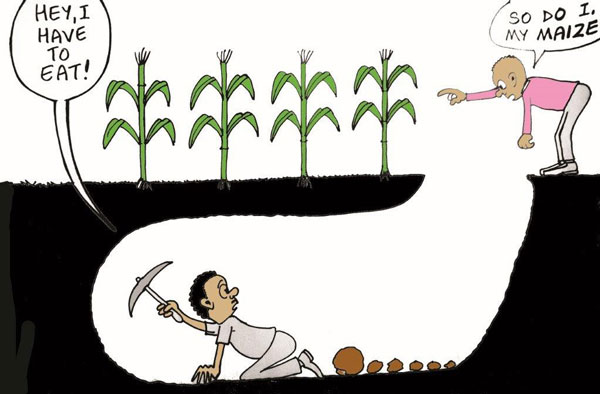
Five years ago, the late esteemed Harare-based agrarian scholar, Professor Sam Moyo, noted that small-scale gold mining and panning had been growing in economic importance — and reshaping land use sharing arrangements.
SAM SPIEGEL / WELLINGTON TAKAVARASHA
He described interviewees in Kwekwe who saw the proliferation of small-scale gold extraction as reflecting “liberation of mineral resources, which had been hidden under the monopolistic large-scale commercial farms”.

Now a half decade later, both farming and small-scale mining continue to be vital pillars of Zimbabwe’s rural economy, and land sharing presents ever-increasing challenges.
In 2015, drought in Zimbabwe led more people to turn to gold mining. As artisanal and small-scale miners across the country are looking ahead now, there is a need to find ways of ameliorating relations between miners and farmers.
In December a national workshop took place in Harare called Visualising Artisanal and Small-Scale Gold Mining: Environmental Strategies for the Future. Contested land use was a key topic discussed by national environmental and mining authorities, small-scale miners, environmental impact assessment (EIA) consultants and other stakeholders.
A theatre group presented scenes of environmental conflicts, which were followed by reconciliation — in “Act 2” — between artisanal miners and environmental authorities. Afterwards, illustrations of artisanal miners’ hardships by Harare-based cartoonist Innocent Mpofu were shared to spark debate on challenges, interpretations and solutions. More than 100 participants worked in groups to discuss images.
The diverse interpretations of the visual (top right) underscored the deep complexities involved. Some groups saw, first and foremost, a farmer’s land being damaged by the miner. Their interpretation of the image focused on degradation, pollution and potential risks to cattle that fall in pits. Others suggested there was a severe lack of understanding by the farmer — and drew on their own experiences.
- Chamisa under fire over US$120K donation
- Mavhunga puts DeMbare into Chibuku quarterfinals
- Pension funds bet on Cabora Bassa oilfields
- Councils defy govt fire tender directive
Keep Reading
Some participants linked the cartoon with the urgent need for enforcing environmental laws and designating more areas for legalised small-scale gold mining. Discussions also accentuated the need for improving safety standards for all underground mining, reminding everyone that going underground can be profoundly dangerous.
Across Zimbabwe, miner-farmer tensions often accrue after miners are awarded prospecting licences. Many face resistance while seeking to peg rights on disputed farmland. More attention needs to be given to the diverse local contexts, histories and relationships at play.
In our research exploring land use challenges related to gold mining in Kadoma, Shamva, Insiza and Mazowe, we found that interpretations vary considerably among miners, and the same can be said for farmers. EIAs are potentially one of the key tools for improving relations between miners and farmers. Many small-scale miners described challenges in paying for EIA consultancy reports (sometimes costing several thousand dollars); others noted long periods of waiting for EIA reports to be processed. We also heard stories of farmers feeling like they were poorly consulted or not consulted at all in EIA reports for mining projects.
Several conflicts have recently been elevated to the status of legal battles. A few weeks ago, an institution near Chinhoyi demolished a gold milling project where about $200 000 was invested, due to a conflict with its farming operations. The miners’ paperwork from the Environmental Management Agency, Zimbabwe investment authority and mining licences were reportedly available, and the case has been taken to the high court.
Academics and journalists often talk about “miners” and “farmers” as if they are different people. In fact, many artisanal and small-scale miners are former or part-time farmers and are not unsympathetic to concerns that farmers have. Yet, if a solution is to be reached, there needs to be much more formal dialogue between all the various parties involved in land use disputes, and practical strategies for minimising environmental risks embraced.
Small-scale miners often want to talk about “cohabitation” — sharing land with farmers — and indeed the Mines and Minerals Act gives preference to mining over farming, an element of law since the years of colonisation. For cohabitation to be a viable solution, miners have to do a better job of environmental stewardship — and giving more attention to preventing pollution, minimising chemical use and backfilling pits all would be good starting points.
In December, the Environmental Management Agency announced plans for a review of the EIA system and increased training of small-scale gold miners in 2016 — a much-welcome move that could present major benefits. Mining has both potentially positive and negative connections to other sectors including agriculture. Finding innovative and mutually beneficial solutions will surely be a high priority for 2016.
Sam Spiegel is a lecturer and director of research at the Centre of African Studies at the University of Edinburgh. Wellington Takavarasha is the director of the Zimbabwe Environment and Mining Institute.











